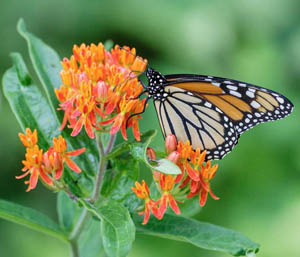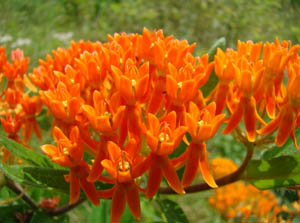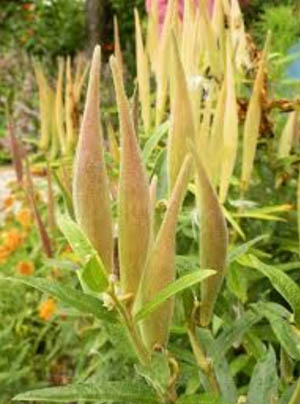Perennial Plant of the Year 2017
Asclepias tuberosa - "Butterfly Weed" or "Milkweed"

Every year the Perennial Plant Association sends each member a ballot to select a Perennial Plant of The Year. These plants tend not to be new introductions to the garden world, but plants that have been tested and thus proven worthy for nomination. They need to be suitable for a wide range of climatic zones. The plant chosen must be low maintenance, relatively pest free, and disease resistant. It must have multiple seasons of ornamental interest and be readily available for the year of promotion. After the selection the plant is promoted all across Canada and continental U.S.A.
“And who is the Perennial Plant Association,” you might ask? Mostly, it is a large group of greenhouse growers, retailers, landscapers, horticultural teachers, and “plant geeks” that work in our huge industry. The membership is large, and people join from all around the world and meet once a year at an annual convention. Here, we listen to speakers, tour greenhouses and nurseries, have a trade show, and in general, find out what the others in the industry are up to.
It began in 1990, when the first Plant of the Year was Phlox stolonifera. Next was Heuchera micrantha “Palace Purple” and from that time on each year another perennial was picked and promoted. Anemone hybrida "Honorine Jobert" was chosen for the 2016 season.
 Most of the time the plants selected by the Perennial Plant Association are very hardy. With the exception of a very few plants that are not hardy at all, Vale's Greenhouse has always been very pleased with the choices for Perennial Plant of the Year. For the 2017 gardening season Asclepias tuberosa has been chosen.
Most of the time the plants selected by the Perennial Plant Association are very hardy. With the exception of a very few plants that are not hardy at all, Vale's Greenhouse has always been very pleased with the choices for Perennial Plant of the Year. For the 2017 gardening season Asclepias tuberosa has been chosen.
Butterfly Weed or Milkweed, the two names Asclepias are most commonly known as, are found in its native location growing wild in dry fields and rocky ditches from Southern Ontario, across the prairies to the Mountains of Montana. This species can be identified by its alternate leaves and unusually orange, rarely yellow or red flowers. A virtually hassle free, long lived perennial which produce flowers from mid July until mid August which are heavily laden with nectar and pollen, which are very attractive to hummingbirds, butterflies, bees and other beneficial insects.
The bright orange flowers make a wonderful cut flower, with their long straight stems. When you pick the flower stems to put in arrangements you should pass each cut stem over an open flame to stop the white sap from leaking out (that is the "Milkweed" part of the name) and then your cut flowers will last for days in the vase. When the pretty orange flowers are finished blooming in the garden large green seed pods develop, which then bust open to reveal seeds with long silky hairs. The seed pods are most desirable for creating beautiful dried and fresh arrangements
Asclepias tuberosa is not considered invasive in Southern Alberta. Don't overwater this sun loving plant, as it loves to grow in a dry rocky or sandy soil. Butterfly Weed grows a long root so it's best to only move plants that are young. As it gets older and larger you will not be able to divide or move it, as there is a good chance it will not survive.
Monarch butterfly larvae only eat Asclepia leaves. When the leaves are ingested a chemical in the leaves make the Monarch larvae distasteful to all predators. Pioneer doctors used this plant as a diuretic and as an anti-rheumatic medicine. The Native American used the white sap from the Milkweed, to treat swelling and rashes.

